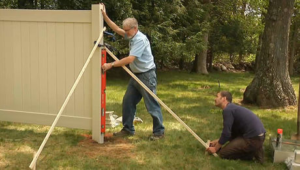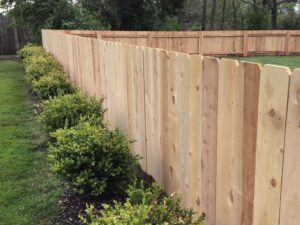Installing a fence can be a complex project. Knowing your property lines and researching neighborhood or city regulations is important.
Locating and marking utility lines is essential to avoid damaging pipes, water lines, and telecommunication cables. Click https://www.maiseyfence.com/ to learn more.

Whether you choose vinyl, wood, or metal, it’s important to understand how much maintenance your fence will require. Keeping up with your fence will ensure its longevity.
While many people assume that having a fence installed is simply a matter of putting up posts and backer rails, a lot of prep work goes into building any type of fence. If you don’t take these steps beforehand, you could end up having a fence that doesn’t meet code or obstructs your neighbors’ views. In addition, your property could be subject to fines if you don’t follow local regulations.
The first step is staking your property line. This is done to ensure that you are building your fence strictly within your own boundaries, which can prevent any problems with your neighbor. It’s also important to get a copy of your property survey, which you can usually obtain from your county records office or city planning and zoning department.
Next, clear obstructions from your soon-to-be fence line. This can include tree stumps, roots, rocks, weeds, and any major slopes. These items will make it difficult for the crew to build your fence and may even pose a safety risk. Taking care of this step before the fence installation company arrives will save you money and time.
Once you have the site prepared, it’s time to dig your fence posts. This process can be a long and tedious job, especially in areas with hard or compact soil. However, it is essential for ensuring that your fence will be strong and secure.
When your posts are dug and seated, it’s time to start installing the panels or pickets. This is the part of the fence that really gives it its defining character. It can be made from a variety of materials and comes in many colors, finishes, and designs.
Before you install your fence panels, you should consider using a wood preservative to protect it from the elements and keep it looking new for a longer period of time. Also, you should apply a coat of stain or sealant to the finished panels or pickets.
Once the panels or pickets are attached to the posts, it’s time to add some finishing touches. This can include post caps, which will help protect the posts from water and weather elements. It’s also a good idea to install some lighting along your fence for added security and curb appeal.
Fences keep kids and pets safe, demarcate property lines and add curb appeal to your home. However, they can also be a substantial expense. A fence that is professionally installed may cost up to $10 per square foot, but you can cut the costs by completing some of the work yourself. In fact, according to Better Homes & Gardens, you can save up to 70% by digging the post holes, purchasing the materials and installing the fencing panels yourself.
First, prepare the area where you plan to install your fence. Clear out the yard and remove any debris or items that could interfere with the construction process. In addition, locate any underground utilities to avoid potential damage or injury. This step is especially important if your fence will be in close proximity to buried utility lines.
Once the site is ready, dig the fence posts using a post-hole digger. A general rule of thumb is to make the hole as deep as 1/3 the height of the post. When digging, be sure to wear appropriate safety gear and use caution to avoid hitting any underground utility lines. You may wish to call your local utility company before digging to have any underground lines marked, which will prevent you from accidentally tearing up a line that needs to be repaired or replaced.
After digging the holes, use a level to check their accuracy and seat the first fence post. Next, add 6 to 8 inches of soil, checking the level again with a level and tamping the dirt to compact it solidly into place. Repeat this process with each fence post, making sure to set corner and end posts first.
Before moving on to the next step, apply a layer of protective sealer or stain to the wood posts and panels. This will help the fence stand up to the elements and prolong its life. After the sealant or stain has dried, you can install the fence panels.
To add finishing touches to your new fence, you can add post caps, gates and decorative hardware. Measure the outside diameter of each fence post with a tape measure to determine the correct size for the post cap. Select a cap that will complement the style of your new fence and install it to the post.
Once the fence posts are set, it’s time to install the rails. Depending on the style of fence you’re getting, your fencing contractors may install the rails on the same day that they dig the post holes or at a later date. Before starting to install the rails, it’s important to check with local utility companies to have all underground lines marked. This is done to ensure safety and avoid costly mistakes as you work.
Depending on the type of fence you’re getting, the next step is installing the panels or pickets to the rails. Both options give your fence its defining look and add privacy and security to your property. If you’re using panels, they can be installed directly onto the fence posts, which helps speed up the process. If you’re using pickets, they will need to be attached one at a time with metal screws or wood nails.
As you complete the installation of your fence, make sure the posts are aligned with the line of the property and that they’re properly spaced. This will help to prevent gaps from forming, which can allow in wind and snow or insects.
If you’re planning on hiring a fence installation company, speak to friends and neighbors to see what they recommend. You can also check online reviews and keep an eye out for company badges or logos nailed to completed fences in your neighborhood. If you plan on installing the fence on your own, take a trip to your local home improvement store to purchase all the materials you’ll need. This will be much cheaper than having the fence contractor buy the materials for you.
If you have the skills and experience to install a fence yourself, it can be a great way to save money and have a fun home improvement project at the same time. With the proper preparation, planning and measuring, as well as a little bit of hard work, you can transform your property with a new, high-quality fence. Just remember to keep safety in mind and follow all local building codes and requirements for fence construction.
During the final inspection, building inspectors will evaluate the completed work to ensure it meets industry standards. Typically, an inspector will review safety measures and verify that the project meets code requirements before declaring it as complete. The inspector will note any issues that need to be addressed and may request additional documentation from the contractor to resolve the issue. A thorough inspection is crucial for minimizing the risk of non-compliance penalties.
The inspection process varies from jurisdiction to jurisdiction, but there are some common items that are included in most final inspection checklists. These include verifying that the structure is safe for occupancy, confirming that all safety measures have been taken, and checking for compliance with egress requirements. Additionally, an inspector will look at the quality of construction, including ensuring that posts are properly positioned and secured, and that rails are attached securely.
A final inspection is also an opportunity for the contractor to review the final paperwork and make sure everything is in order. This includes a copy of the inspection report, all permit certificates, and an invoice for payment. An owner or their representative is typically allowed to attend a final inspection but should not interfere or attempt to alter the inspection.
For many businesses, using a final inspection checklist is an essential tool for ensuring compliance with regulations. By providing a structured approach to inspections, a checklist can help reduce human error and ensure meticulous compliance with industry standards.
While it is possible to install a fence on your own, hiring a professional team can save you time and money. A professional team will have years of experience, and they can install a fence quickly and correctly.
To find a good fence installation company, start by asking for recommendations from friends and family. Then, check online reviews and speak to the company’s customer service department. Finally, ask about their warranty policies and procedures.
Before the fence builders arrive, the estimators will visit your property to determine what type of fencing you need and how much material is needed. They will then provide you with a cost estimate and schedule the construction. They will likely arrange for the local utility marking service to visit your site before the fence builders begin digging to ensure that they don’t damage any existing lines.

